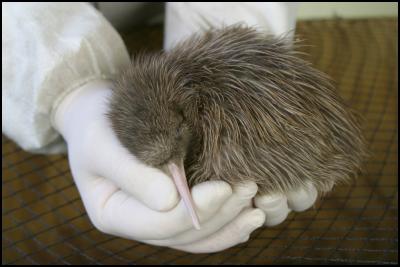Image: Haast Kiwi Chick – First In Queenstown

PHOTO CAPTION: The
gentle hands of Paul Wilson, the Kiwi and Birdlife Park
Director, move the newly born Haast tokoeka chick for
weighing. (Photo by Michael
Brabant)
The birth of a Haast tokoeka kiwi chick in Queenstown marks a milestone for the Bank of New Zealand Kiwi Recovery’s Operation Nest Egg programme, West Coast Coast Conservator Mike Slater announced today.
“This is the first time that a Haast tokoeka egg has been hatched outside of the wild and it’s a very important step in our management of the Haast Tokoeka Sanctuary, Mr Slater said.
“Up until now information about incubation and hatching has been a vital missing gap in our knowledge about the early life of these rare birds,” Mr Slater said.
In about two weeks DOC rangers will release the chick inside the predator fence at Burwood Reserve where it can grow to a stoat-proof size before returning to the Haast Tokoeka Sanctuary next year.
Early last month DOC rangers carefully lifted the egg from a nest located in the remote outer edge of the sanctuary and used life support techniques developed through the Bank of New Zealand Kiwi Recovery’s Operation Nest Egg programme to deliver it to the Kiwi and Birdlife Park incubation facility at Queenstown.
“The great work done by Matt Wong and his team at the Kiwi and Birdlife Park to hatch this egg is a glowing example of how kiwis are working to save kiwi through the Bank of New Zealand Kiwi Recovery Trust,” Mr Slaters said.
DOC intends to hatch two more chicks under the programme, but is not currently using the technique to maintain the population.
“The stoat trapping programme in the Haast Tokoeka Sanctuary is working very well, so this is an opportune time to confirm whether or not we also have the option of removing eggs to safety if we are unfortunate enough to strike a season of unusually high numbers of rats and stoats,” Mr Slater said.
In the wild kiwi chicks are not nursed by their parents and they must feed themselves to survive. To do this they forage in the forest for extended periods which leaves them exposed to stoat attack.
“The next ten days will be very critical for this chick. This is the time when it has to teach itself to feed before it finishes absorbing its yoke sac. It is a difficult transition period and there is nothing that can be humanly done to assist,” Mr Slater said.
The Haast Tokoeka Sanctuary covers 11,400ha and is 25kms South of Haast township in South Westland. The sanctuary is home to an estimated 200-300 tokoeka which are ranked as a nationally critical species. DOC maintains a network of 1486 stoat traps throughout the sanctuary to reduce chick predation and boost population’s breeding success rate.
ENDS


 NIWA: Antarctic Footprint Clean-up Challenges - How A Remote Antarctic Base Clean-up Protected One Of Earth’s Clearest Lakes
NIWA: Antarctic Footprint Clean-up Challenges - How A Remote Antarctic Base Clean-up Protected One Of Earth’s Clearest Lakes Hugh Grant: Can A Meme Coin Become A Real Payment Solution?
Hugh Grant: Can A Meme Coin Become A Real Payment Solution? Imported Motor Vehicle Industry Association: EV Battery Fires Expose New Zealand Regulatory Gap
Imported Motor Vehicle Industry Association: EV Battery Fires Expose New Zealand Regulatory Gap  Electricity Authority: Electricity Authority Welcomes Plan To Empower Consumers And ‘Make NZ More Electric’
Electricity Authority: Electricity Authority Welcomes Plan To Empower Consumers And ‘Make NZ More Electric’ Pamu Farms: New Zealand Farm Dog Genetic Study Shows Top Five Health Risks
Pamu Farms: New Zealand Farm Dog Genetic Study Shows Top Five Health Risks EDANZ: Payments NZ Forcing The World’s Most Aggressive Removal Of EFTPOS Terminals
EDANZ: Payments NZ Forcing The World’s Most Aggressive Removal Of EFTPOS Terminals


